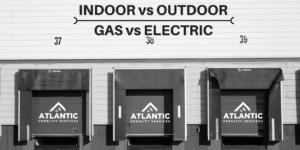 The Electric vs. Gas forklift debate involves a little more than which use may be best for your indoor facility. There are very real differences if you will be using your lift outdoors, as well.
The Electric vs. Gas forklift debate involves a little more than which use may be best for your indoor facility. There are very real differences if you will be using your lift outdoors, as well.
We’ve covered the cost difference, so let’s just talk about functionality, starting with a gas-powered lift.
Gas-powered lifts can just flat-out lift heavier loads than an electric lift. This, alone, may be the deciding factor in your purchase.
The performance of the gas-powered life remains constant even as the unit’s fuel supply is running low. That’s not necessarily the case in a battery-powered lift.
Using a gas-powered lift means generally you don’t have to be concerned with managing the exhaust of the unit.
If you run out of gas your lift will only be down for a moment, while you refill the tank. An electric forklift may be out of service for a bit as it recharges.
On the other hand, some of the maintenance costs for an internal combustion lift can be more expensive than an electric lift.
In an electric lift, you may not be able to manage the big loads a gas-powered lift can handle, but with a lower center of gravity, these lifts are more stable at higher lift heights.
Your overall fuel costs for an electric lift will be lower, but as we mentioned when an electric lift runs out of power it’s down for the count.
Electric lifts can, for the most part, out maneuver a gas-powered lift but they are somewhat less suitable for outdoor use as they have lower ground clearance and some traction concerns. This is less of a factor if you are operating on a paved surface like a loading dock or parking lot, but if you are operating mostly on an uneven or unpaved surface an electric forklift may not suit your needs.
Consider all these points if you will be using your lift outdoors, and of course we’re always available for any questions you may have. Don’t hesitate to ask!
